When you start the car, it is perfectly normal for the car battery warning light to illuminate. The light should go out after a few seconds. If the battery light stays on while driving, this means that the charging system does not work, but it does not necessarily depend on the battery. You will probably notice other signs of low battery, such as your windows not moving as fast or the stereo not working. A warning light can signal several different problems under the hood, from a damaged battery to problems with the generator. Before you take out the jump leads or buy a new car battery, you can read the car battery guide to see what makes the warning light on the instrument panel.
Why does the car battery's indicator light come on?
The car battery's warning light is one of the most misunderstood warning lights in the car. Most people immediately assume that this means that the battery is bad when the warning light is on. This is usually also true, but the lamp does not always light up for that reason. It can e.g. also mean that you have problems with the generator or regulator. The generator charges the battery with kinetic energy from the engine. If the generator breaks down, it stops charging the battery and then the car does not get enough voltage. The car battery warning light may also illuminate for the following reasons:
- A loose or corroded battery cable;
- Broken generator ;
- Broken generator regulator;
- Damaged cells inside the battery;
- Problems with the cables in the car's electrical charging system.
Therefore, it is best to check the other parts and cables carefully to find the reason why the warning light is on.
Read more: How to test your alternator
Broken generator
Symptoms of a broken generator can be:
- The car does not start;
- Misty or irregular headlights;
- Roaring or whining sounds;
- Devices such as windshield wipers, windows, etc. are not activated.
You can check if the generator works with a digital multimeter . The voltage should be between 13.6 and 14.6 volts. If the voltage is below 12 volts, the battery light will start to light and then you will probably need to replace the generator.
The generator regulator regulates that the voltage is 14.5 volts, so this can also be a cause of the problem.
Read more: scv signs of a faulty suction control valve
Broken V belt
This is perhaps the most serious problem because the V-belt drives the generator, the engine's radiator pump and the power steering, and it connects all the parts. The V-belt can crack over time or if it is incorrectly adjusted. If the warning light for the engine also lights up and you notice that either the engine temperature is increasing or that the car is more difficult to steer, you may have problems with the V-belt. It is strongly recommended that you stop the car in a safe place and call for salvage and replace the V-belt . If you continue to drive with a broken V-belt, you can cause serious damage to the engine, and in the worst case, it may break completely.
Broken battery
Most car batteries consist of a lead dioxide plate and a solution with sulfuric acid electrolytes. As the battery ages, the plates may break and the electrolyte solution may leak. If this happens, the car battery must be replaced. Damaged cables can also lead to the car battery not being able to take in or retain a charge.
Read more :The dynamo in the car: its importance and the symptoms of stopping work
Corroded battery terminals
The positive and negative battery terminals are the power channels. Sometimes corrosion can accumulate on top of the battery terminals, especially during the summer months or if you drive in very hot climates. Corroded electrical components are poor at conducting electricity. Corrosion is the white, blue or green coating that builds up on the battery terminals. If the battery terminals are covered with corrosion, it is important that you clean them. It is easy and cheap to clean the battery terminals. Do not try to remove the corrosion with your hands. It is an acid solution that can corrode the car's color and irritate the skin, so wear gloves.
Remove the terminal covers, disconnect the battery cables and scrub the terminals thoroughly. Use a stiff brush and a solution of 1 tablespoon of baking soda dissolved in 1 cup of water. The solution is alkaline so it neutralizes the acid in the corrosion.
Broken or loose battery cable
Battery cables transmit power from the battery to the vehicle. Sometimes the battery light is on because there is a bad connection between the battery and the cables connected to it. The battery cables should fit well and you should be able to move the cables around the bracket. If the clamps are loose, tighten them with a wrench or pliers.
Bad ground cable
The ground cable connects various components in the vehicle so that the electricity can flow correctly. In other words, the cable supplies different parts of the car with electricity. It is the thick, black cable that connects to the battery's negative terminal on one side, and the car's chassis on the other side. If the cable is damaged or disconnected, the battery cannot be charged. The symptoms of a damaged or loose negative battery cable are easy to recognize and they will gradually get worse:
- Flashing lights . If the ground cable is damaged or worn, it will not be able to supply the headlights with continuous power, which will cause them to flash or not have full power.
- Low voltage . If you notice that the car does not feel as strong as usual, you can do a voltage test on the battery with a digital multimeter. The voltage must be below 12 volts. If you have a low voltage below 11.5 volts, you should perform a troubleshooting by first checking the ground cable.
- Discharged battery . There can be several reasons why the battery has died, such as problems with the generator or the cord that is connected from the generator to the battery. If these parts work properly, and you still have a dead battery, then the problem is probably due to a loose ground cable.
- Visible damage to the ground cable . Perform a visual inspection on the cable. If the ground cable is visibly damaged or worn, replace it.
Too many devices are used
The V belt drives the generator and connects all electrical equipment and supplies the car's equipment with power. If you use all the equipment very much, it can draw too much electricity. If you use an aftermarket sound system, it can e.g. have an amplifier that uses more power than the generator can handle.
Read more: Testing the function of the alternator: This is how professionals test and measure
What should you do if the battery light comes on while you are driving?
If you drive and the battery light is on, you know that you probably do not have much time to stop before the car is switched off completely. With that in mind, you should focus on finding a safe place to stop and call for roadside assistance. Remember that you can lose power steering to and from, making it more difficult to control the car, and then losing all power resulting in a total loss of control. Turn off all electrical systems in the car that you do not need, such as stereo, air conditioning, seat heating, etc. It is safe to drive without headlights, but also turn them off to save energy. Whatever you do, do not turn off the engine until you have found a safe place to stop! The starter motor also requires a lot of power, and if there is not enough charge in the battery, the car will not start. It is also important to keep an eye on the temperature gauge as overheating can occur when you have a problem with the battery charge.










